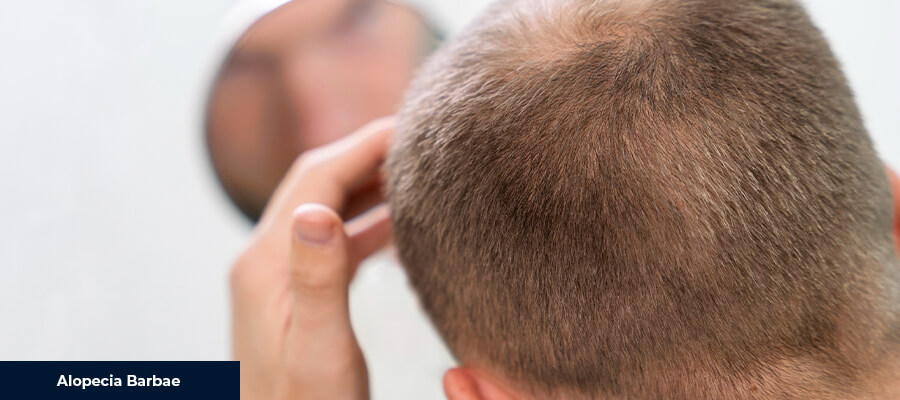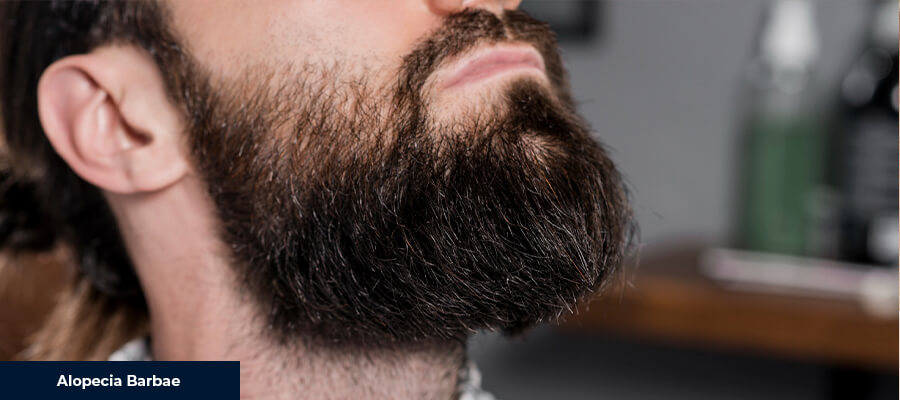Alopecia Barbae: Causes and Solutions

Recognizing and Treating Beard Hair Loss
Alopecia Barbae, or the sudden appearance of beard bald spots, has become popular among many men. As public awareness of this autoimmune hair loss condition grows, so do the questions surrounding it. What is Alopecia Barbae, exactly? How is it diagnosed, and, more importantly, what is the treatment for Alopecia Barbae? If these thoughts have occurred to you, you are not alone. This guide aims to provide in-depth information about Alopecia Barbae, debunking myths and promoting a better understanding of this often-misunderstood condition.
Dispelling Myths and Providing Insight
Alopecia Barbae can impact men’s self-esteem because beards are associated with masculinity and personal style. While hair loss on the scalp is widely discussed and understood, beard hair loss is frequently shrouded in mystery and misinformation. We hope this guide will shed light on the realities of Alopecia Barbae, providing valuable insights for those directly or indirectly affected by this condition.
Understanding the causes, symptoms, and treatment options for Alopecia Barbae can benefit those suffering from the condition. Men can better navigate their health journeys and make informed decisions about their care if they have the correct information. Let’s go deeper into the world of Alopecia Barbae now.
What Is Alopecia Barbae?
Alopecia Barbae is an autoimmune hair loss condition that is a subset of Alopecia Areata. It affects men’s beards, causing one or more beard bald spots to develop. The condition is non-scarring, which means that the hair follicles remain intact, allowing for hair regrowth.
While Alopecia Barbae refers to hair loss in the beard area, it’s important to note that it’s part of a larger category of conditions known as alopecia, which refers to hair loss in any part of the body. Alopecia Barbae is a type of Alopecia Areata that causes hair loss on the scalp, brows, or entire body. We can better understand Alopecia Barbae’s unique characteristics and treatment protocols by distinguishing it as a specific form of this broader condition.
Understanding that Alopecia Barbae is a non-scarring form of hair loss is critical. This implies that the hair follicles remain intact even as the hair falls out. They’re just dormant, which means they have the potential to regrow hair. This aspect provides hope and various treatment options, which we will discuss further in this article.
The Symptoms and Diagnosis of Alopecia Barbae
The sudden appearance of one or more circular or oval beard bald spots is one of the most telling symptoms of Alopecia Barbae. These patches may vary in size and may merge or expand over time. If you notice such changes in your beard, you should see a dermatologist or trichologist. Examining the affected areas allows them to diagnose Alopecia Barbae. Sometimes, a biopsy might be necessary to confirm the diagnosis of beard hair loss and eliminate other possible causes.
Diagnosis of Alopecia Barbae
Detecting Alopecia Barbae in its early stages can be difficult. Some men may dismiss the first signs of beard bald spots as natural or uneven growth, which is why knowing the symptoms of the condition is critical. Individuals who recognize the signs early can seek professional advice promptly, increasing the chances of effective management and treatment.
Healthcare professionals typically diagnose Alopecia Barbae by conducting a clinical examination to inspect the bald spots on the beard that indicate the condition. Additional diagnostic tools may be used to supplement the diagnosis and rule out other potential conditions. A hair pull test, trichoscopy, or, in some cases, a skin biopsy may be among these tools. The goal is to establish a definitive diagnosis to implement an effective treatment plan.
Alopecia Barbae as an Autoimmune Hair Loss Condition
Alopecia Barbae is an autoimmune hair loss condition in which the body’s immune system mistakenly attacks its hair follicles, resulting in hair loss. While the precise cause of this immune response is still unknown, genetic and environmental factors are thought to play a role. We can better understand Alopecia Barbae’s unpredictability and varying course if we understand it is an autoimmune disorder.
Some people may find the idea of the body attacking its own cells perplexing. However, this action is at the heart of autoimmune disorders. The immune system—specifically, white blood cells—targets the hair follicles in the beard area, resulting in hair loss in Alopecia Barbae. This autoimmune reaction can be localized, affecting only a few follicles, or generalized, affecting larger areas of the beard.
Alopecia Barbae, like other autoimmune diseases, has no known cause. A combination of genetic predispositions and environmental triggers instead causes the disease. Because of this multifactorial origin, it can be difficult to predict who will develop Alopecia Barbae and how severe their condition will be. Nonetheless, research in this area is ongoing, and progress is being made in understanding the complex interactions resulting from autoimmune hair loss.
Alopecia Barbae Treatment: Possible Solutions for Bald Spots in the Beard
The good news for those suffering from Alopecia Barbae is that several treatment options are available. Hair regrowth is possible in this condition because the hair follicles remain intact, and many men experience it spontaneously. Alopecia Barbae treatment options for those seeking more proactive methods may include topical applications, corticosteroid injections, and more advanced therapies such as platelet-rich plasma (PRP) therapy or even hair transplant procedures in more severe cases.
The treatment for Alopecia Barbae primarily aims to suppress the autoimmune reaction, protect the hair follicles from further damage, and promote hair regrowth. The severity of the condition frequently determines the treatment approach chosen, the patient’s overall health, and their personal preferences. While treatment can promote hair regrowth, it does not cure the underlying autoimmune condition.
Alopecia Barbae’s psychological impact should not be underestimated. As a result, open discussions with healthcare providers about the emotional and psychological aspects of the condition are critical. Counseling or support groups may be beneficial in some cases. Remember, it’s not just about treating the physical symptoms of hair loss; it’s also about addressing the psychological effects that come with it.
Alopecia Barbae Topical Treatments
Topical corticosteroids are one of the first-line treatments for Alopecia Barbae. These powerful anti-inflammatory agents inhibit the immune response that causes beard hair loss, promoting hair regrowth. Minoxidil is another common topical treatment that is applied to beard bald spots twice daily to stimulate hair follicles.
Corticosteroids applied topically can reduce inflammation and suppress the local immune response. They can protect the hair follicles and allow for hair regrowth by doing so. However, topical corticosteroids, like all medications, can cause side effects such as skin thinning or changes in skin color. As a result, these should never be used without the of a healthcare provider.
Minoxidil, which is more commonly associated with scalp hair loss, is another topical treatment for Alopecia Barbae. It promotes hair regrowth by extending the growth phase of hair follicles. It is generally safe and simple to use, but there may be side effects, as with any medication. In rare cases, users may experience skin irritation or unwanted hair growth in areas adjacent to the treatment area. Before beginning treatment, discussing these options with your healthcare provider is critical.

Corticosteroid Injections: A Progressive Approach
Topical treatments may not produce the desired results for some men. A dermatologist may advise corticosteroid injections in such cases. These injections, which are administered directly into the beard bald spots, suppress the local immune response, allowing for hair regrowth.
Corticosteroid injections are effective in many cases of Alopecia Barbae, and they are frequently considered when topical treatments have failed. These injections deliver The medication directly to the affected area, increasing its effectiveness. They can, however, be uncomfortable, and some patients may experience side effects such as skin thinning at the injection site.
It’s critical to understand that corticosteroid injections can help, but they don’t cure Alopecia Barbae. The treatment only alleviates the symptoms, and hair loss may reoccur in the future. As a result, patients are encouraged to visit their dermatologists on a regular basis to monitor their progress and make any necessary changes to their treatment plans.
Advanced Therapies: PRP and Hair Transplants
Advanced therapies such as PRP and hair transplants may be considered if the above methods have not yielded satisfactory results. Platelet-rich plasma (PRP) therapy involves extracting growth factor-rich platelets from the patient’s own blood through centrifugation. When injected into beard bald spots, these concentrated platelets promote hair regrowth.
PRP Therapy and Hair Transplantation
Platelet-rich plasma (PRP) therapy is a newer treatment option for various hair loss conditions, including Alopecia Barbae. PRP involves drawing a small amount of blood from the patient, spinning it down to separate the platelets, and injecting the platelet-rich plasma into the beard bald spots. Platelets secrete growth factors, which stimulate hair follicles and promote hair regrowth.
Meanwhile, hair transplantation is usually reserved as a last resort for Alopecia Barbae treatment. Hair follicles are transplanted from a donor site (typically the back or side of the scalp) to the beard area. This method may offer a more long-term solution to beard hair loss. It’s worth mentioning that getting a hair transplant is a serious decision that involves surgery. Therefore, it’s essential to thoroughly weigh the potential advantages and disadvantages before proceeding.
Early Intervention of Alopecia Barbae
To summarize, dealing with Alopecia Barbae can undoubtedly be difficult. By gaining a deeper knowledge of the condition and the various treatment options that exist, it is possible to manage and address beard hair loss efficiently. If you notice beard bald spots or other changes in your beard hair, you should consult a healthcare professional to discuss your symptoms and determine the best Alopecia Barbae treatment. Remember that early intervention is critical in the treatment of autoimmune hair loss conditions such as Alopecia Barbae.
Instagram: smilehairclinic
 Whatsapp
Whatsapp
